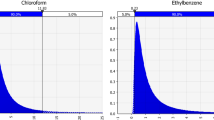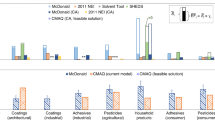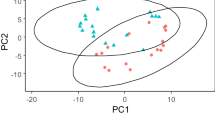Abstract
Air pollution standards and control strategies are based on ambient measurements. For many outdoor air pollutants, individuals are closer to their sources (especially traffic) and there are important indoor sources influencing the relationship between ambient and personal exposures. This paper examines the relationship between volatile organic compounds (VOCs) measured at central site monitoring stations and personal exposures in the Mexico City Metropolitan Area. Over a 1-year period, personal exposures to 34 VOCs were measured for 90 volunteers from 30 families living close to one of five central monitoring stations. Simultaneous 24-h indoor, outdoor and central site measurements were also taken. Dual packed thermal desorption tubes and C18 DNPH-coated cartridges were used for sampling VOCs and these were analyzed by GC/MS and HPLC, respectively. A factor analysis of the personal exposure data aided in grouping compounds by the most likely source type: vehicular (BTEX, styrene and 1,3-butadiene), secondary formed or photochemical (most aldehydes), building materials and consumer products (formaldehyde and benzaldehyde), cleaning solvents (tetrachloroethene and 1,1,1-trichloroethane), volatilization from water (chloroform and trichloroethene) and deodorizers (1,4-dichlorobenzene). Mean ambient, indoor and personal concentrations were 7/7/14 μg/m3 for benzene, 1/3/3 for 1,3-butadiene, 6/20/20 for formaldehyde and 3/9/50 for 1,4-dichlorobenzene. Geometric mean (GM) ambient concentrations of trichloroethene and carbon tetrachloride were similar to GM personal exposures. While outdoor and indoor home GM concentrations for most vehicular related compounds (benzene, MTBE, xylenes and styrene) were comparable, the GM personal exposures were twice as high. Indoor concentrations of 1,3-butadiene, 1,1,1-trichloroethane, tetrachloroethane, chloroform, formaldehyde, valeraldehyde, propionaldehyde and n-butyraldehyde were comparable to personal exposures. For certain compounds, such as chloroform, aldehydes, toluene, 1,3-butadiene and 1,4-dichlorobenzene, GM personal exposures were more than two times greater than GM ambient measurements.
This is a preview of subscription content, access via your institution
Access options
Subscribe to this journal
Receive 6 print issues and online access
$259.00 per year
only $43.17 per issue
Buy this article
- Purchase on Springer Link
- Instant access to full article PDF
Prices may be subject to local taxes which are calculated during checkout


Similar content being viewed by others
References
Anderson M.J., Daly E.P., Miller S.L., and Milford J.B. Source apportionment of exposures to volatile organic compounds: II. Application of receptor models to TEAM Study data. Atmos Environ 2002: 36: 3643–3658.
Anderson M.J., Miller S.L., and Milford J.B. Source apportionment of exposure to toxic volatile organic compounds using positive matrix factorization. J Expos Anal Environ Epidemiol 2001: 11: 295–307.
Arnts R.R., and Tejada S.B. 2,4-Dinitrophenylhydrazine-coated silica gel cartridge method for determination of formaldehyde in air: identification of an ozone interference. Communications. Environ Sci Technol 1989: 23 (11): 1428–1430.
Brown S.K. Progress towards national indoor air quality goals for volatile organic compounds. Report of the Air Quality Panel of the National Health and Medical Research Council, Australia,, 1992.
Cao X.-L., and Hewitt C.N. Study of the degradation by ozone of adsorbents and of hydrocarbons adsorbed during the passive sampling of air. Environ Sci Technol 1994: 28: 757–762.
Chan C.-C., Lin S.-H., and Her G.-R. Office worker's exposure to volatile organic compounds while commuting and working in Taipei City. Atmos Environ 1994: 28 (14): 2351–2359.
Chan C.-C., Spengler J.D., Özkaynak H., and Lefkopoulou M. Commuter exposures to VOCs in Boston, Massachusetts. J Air Waste Manage Assoc 1991: 41 (12): 1594–1600.
Clayton C.A., Pellizzari R.W., Whitmore R.W., Perritt R.L., and Quackenboss J.J. National Human Exposure Assessment Survey (NHEXAS): distributions and associations of lead, arsenic and volatile organic compounds in EPA region 5. J Expos Anal Environ Epidemiol 1999: 9 (5): 381–392.
Dor F., Moullec Y.L., and Festy B. Exposure of city residents to carbon monoxide and monocyclic aromatic hydrocarbons during commuting trips in the Paris Metropolitan Area. Technical paper. J Air Waste Manage Assoc 1995: 45: 103–110.
Edwards R.D., Jurvelin J., Saarela K., and Jantunen M. VOC concentrations measured in personal samples and residential indoor, outdoor and workplace microenvironments in EXPOLIS-Helsinki, Finland. Atmos Environ 2001: 35: 4531–4543.
Fleiss J.L. The Design and Analysis of Clinical Experiments. Wiley, New York, 1999.
Geyh A.S., Wolfson J.M., Koutrakis P., Mulik J.D., and Avol E.L. Development and evaluation of a small active ozone sampler. Environ Sci Technol 1997: 31 (8): 2326–2330.
Gordon S.M., Callahan P.J., Nishioka M.G., Brinkman M.C., O'Rourke M.K., and Lebowitz M.D., et al. Residential environmental measurements in the National Human Exposure Assessment Survey (NHEXAS) Pilot Study in Arizona: preliminary results for pesticides and VOCs. J Expos Anal Environ Epidemiol 1999: 9: 456–470.
Grosjean E., and Grosjean D. Performance of DNPH-coated C18 cartridges for sampling C1–C9 carbonyls in air. Intern J Environ Anal Chem 1995: 61: 343–360.
Hamlett A., Ryan L., Serrano-Trespalacios P., and Wolfinger R. Mixed models for assessing correlation in the presence of replication. J Air Waste Manage Assoc 2003: 53 (4): 442–450.
Hartwell T.D., Pellizzari E.D., and Perritt R.L., et al. Results from the Total Exposure Assessment Methodology (TEAM) Study in selected communities in Northern and Southern California. Atmos Environ 1987: 21 (9): 1995–2004.
Hatcher L. A Step-by-step Approach to Using the SAS® System for Factor Analysis and Structural Equation Modeling, 3rd printing. SAS Institute Inc., NC, USA, 1994.
Helmig D. Artifact-free preparation, storage and analysis of solid adsorbent sampling cartridges used in the analysis of volatile organic compounds in air. J Chromatogr 1996: 732: 414–417.
Hodgson A.T., Apte M.G., Shendell D.G., Beal D., and McIlvaine J.E.R. Implementation of VOC source reduction practice in a manufactured house and in school classrooms. Proceedings of Indoor Air 2002, Monterey, CA, USA, 2002.
Hodgson A.T., Fisk W.J., Shendell D.G., and Apte M.G. Predicted Concentrations in New Relocatable Classrooms of Volatile Organic Compounds Emitted from Standard and Alternate Interior Finish Materials, Environmental Energy Technologies Division, E.O. Lawrence Berkeley National Laboratory, LBNL 48490, July 18,, 2001.
Hodgson A.T., Rudd A.F., Beal D., and Chandra S. Volatile organic compound concentrations and emission rates in new manufactured and site-built houses. Indoor Air 2000: 10: 178–192.
Hoffmann K., Krause C., Seifert B., and Ullrich D. The German Environmental Survey 1990/92 (GerES II): sources of personal exposure to volatile organic compounds. J Expos Anal Environ Epidemiol 2000: 10 (2): 115–125.
INEGI (Instituto Nacional de Estadística, Geografía e Informática). Estadísticas del Medio Ambiente del Distrito Federal y Zona Metropolitana,, 1999: (http://hades.inegi.gob.mx/sitio_inegi/contnal/medioambiente/mediodf/estadis/ciib215.html) (accessed April 2, 2003, actualized June 23, 1999).
INEGI (Instituto Nacional de Estadística, Geografía e Informática). XII Censo General de Población y Vivienda. México, 2000.
Jantunen M.J., Hännien O., and Katsouyanni K., et al. Air pollution exposure in European cities: the “EXPOLIS” study. J Expos Anal Environ Epidemiol 1998: 8 (4): 1–24.
Jones A.P. Indoor air quality and health. Atmos Environ 1999: 33: 4525–4564.
Kelly T.J., Smith D.L., and Satola J. Emission rates of formaldehyde from materials and consumer products found in California homes. Environ Sci Technol 1999: 33 (1): 81–88.
Kleindienst T.E., Corse E.W., Blanchard F.T., and Lonneman W.A. Evaluation of the performance of DNPH-coated silica gel and C18 cartridges in the measurement of formaldehyde in the presence and absence of ozone. Environ Sci Technol 1998: 32 (1): 124–130.
Kumai M., Koisumi A., Saito K., Sakurai Y., Takeuci H., and Inoune T. A nationwide survey on organic solvent components in various solvent products: part 2. Heterogeneous products such as paints, inks and adhesives. Ind Health 1983: 21 (1): 85–197.
Landrigan P.J., Stein G.F., Kominsky J.R., Ruhe R.L., and Watanabe A.S. Common-source community and industrial exposure to trichloroethylene. Arch Environ Health 1987: 42 (6): 327–332.
Lebret E., van de Wiel H.J., Bos H.P., Noij D., and Boleij J.S.M. Volatile organic compounds in Dutch homes. Environ Int 1986: 12: 323–332.
Lee K., Yanagisawa Y., Spengler J.D., and Davis R. Assessment of precision of a passive sampler by duplicate measurements. Environ Int 1995: 21 (4): 407–412.
Mølhave L. Indoor air pollution due to organic gases and vapors of solvents in building materials. Environ Int 1982: 8: 117–127.
Norman G.R., and Streiner D.L. Biostatistics the Bare Essentials. Mosby, MO, USA, 1994.
Ortiz-Romero M.E. Campaña de Monitoreo de Partículas y de Algunos Precursores de Ozono, como Indicadores de Base para Estudios de Efectos a la Salud en la Ciudad de México D.F., 1st Volume. CONSERVA (Consejo de Estudios para la Restauración y Valoración Ambiental), México D.F. Report of 1998 and 1999 Studies,, 2000: pp. 155–223.
Pellizzari E., Lioy P., and Quackenboss J., et al. Population-based exposure measurements in EPA region 5: phase I field study in support of the National Human Exposure Assessment Survey. J Expos Anal Environ Epidemiol 1995a: 5 (3): 327–358.
Pellizzari E., Michael L.C., Thomas K.W., Shields P.G., and Harris C. Identification of 1,3-butadiene, benzene, and other volatile organics from wok oil emissions. J Expos Anal Environ Epidemiol 1995b: 5 (1): 77–87.
Pellizzari E.D., Perrit R.L., and Clayton C.A. National Human Exposure Assessment Survey (NHEXAS): exploratory survey of exposure among population subgroups in EPA region V. J Expos Anal Environ Epidemiol 1999: 9 (1): 49–55.
Ramstrom S. January 2004, personal communication, Harvard School of Public Health, Boston, MA, USA. (recalculated from Kinney PL, Chillrud SN, Ramstrom S, Ross J, Spengler JD. Exposure to multiple air toxics in New York City. Environ Health Perspect 2002: 110 (4): 539–546 ).
Reiss R., and Roberts P.T. A review of the literature of methods for measuring carbonyls in the atmosphere with DNPH cartridges. Final Report STI-997390-1724-FR, WA III-136, Prepared for JoAnn Rice US EPA, Sonoma Technology, Inc., September 30,, 1997.
Reiss R., Ryan P.B., Koutrakis P., and Tibbetts S.J. Ozone reactive chemistry on interior latex paint. Environ Sci Technol 1995b: 29 (8): 1906–1912.
Reiss R., Ryan P.B., Tibbetts S.J., and Koutrakis P. Measurement of organic acids, aldehydes, and ketones in residential environments and their relation to ozone. J Air Waste Manage Assoc 1995a: 45: 811–822.
Risner C.H. High-performance liquid chromatographic determination of major carbonyl compounds from various sources in ambient air. J Chromatogr Sci 1995: 33: 168–176.
Romieu I., Ramirez M., and Meneses F., et al. Environmental exposure to volatile organic compounds among workers in mexico City as assessed by personal monitors and blood concentrations. Environ Health Perspect 1999: 107 (7): 511–515.
Rosner B. Fundamentals of Biostatistics, 4th ed. Duxbury, Harrisonburg, VA, 1995.
Sack T.M., Steele D.H., Hammerstrom K., and Remmers J. A survey of household products for volatile organic compounds. Atmos Environ 1992: 26A (6): 1063–1070.
Seifert B., and Abraham H.J. Indoor air concentrations of benzene and some other aromatic hydrocarbons. Ecotoxicol Environ Saf 1982: 6 (2): 190–192.
Serrano-Trespalacios P.I. Assessment of human exposure and cancer risk of volatile organic compounds in Mexico City. Dissertation, Harvard University, Boston, MA, 2003.
Shields P.G., Xu G.X., and Blot W.J., et al. Mutagens from heated Chinese and US cooking oils. J Natl Cancer Inst 1995: 87 (11): 836–841.
Spectrum Laboratories. Chemical Fact Sheet — CAS # 100425, Styrene. Internet, (http://www.speclab.com/compounds/c100425.htm) (accessed June 26, 2002), 2002.
Tapia-Conyer R., Kuri-Morales P., and Hoy-Gutiérrez M.J. An Epidemiologic Overview of Smoking in Mexico. Salud Publica Mex 2001: 43: 478–484.
Tichenor B.A., and Mason M.A. Organic emissions from consumer products and building materials to the indoor environment. J Air Pollut Control Assoc 1988: 38: 264–268.
Umweltbundesamt.de (The Federal Environmental Agency—Germany). German Environmental Survey (GerES) (http://www.umweltbundesmt.de/survey-e/index.httm) Last update: 27.08.2002 (accessed Sep 20, 2003), 2003.
US EPA (United States Environmental Protection Agency). The Total Exposure Assessment Methodology (TEAM) Study: Summary and Analysis, Volume 1. EPA/600/6-87/002a, Office of Research and Development, Washington, DC,, 1987.
US EPA (United States Environmental Protection Agency). Compendium Method TO-17: Determination of Volatile Organic Compounds in Ambient Air Using Active Sampling Onto Sorbent Tubes, EPA/625/R-96/010b, Center for Environmental Research Information, Office of Research and Development, Cincinnati, OH,, 1997.
Wallace L. Major sources of exposure to benzene and other volatile organic chemicals. Workshop on indoor air quality. Risk Anal 1990: 10 (1): 59–64.
Wallace L.A. Human exposure to volatile organic pollutants: implications for indoor air studies. Annu Rev Energy Environ 2001: 26: 269–301.
Wallace L., Pellizzari E.D., Hartwell T.D., Perritt R., and Ziegenfus R. Exposure to benzene and other volatile compounds from active and passive smoking. Arch Environ Health 1987a: 42 (5): 272–279.
Wallace L.A., Pellizzari E.D., Hartwell T.D., Sparacino C.M., Sheldon L.S., and Zelon H. Personal exposures, indoor–outdoor relationships, and breath levels of toxic air pollutants measured for 355 persons in New Jersey. Atmos Environ 1985: 19 (10): 1651–1661.
Wallace L.A., Pellizzari E.D., Hartwell T.D., Whitmore R., Sparacino C., and Zelon H. Total Exposure Assessment Methodology (TEAM) Study: personal exposures, indoor–outdoor relationships, and breath levels of volatile organic compounds in New Jersey. Environ Int 1986: 12: 369–387.
Wallace L.A., Pellizzari E., Leadered B., Zelon H., and Sheldon L. Emissions of volatile organic compounds from building materials and consumer products. Atmos Environ 1987b: 21 (2): 385–393.
Weschler C.J., Hodgson A.T., and Wooley J.D. Indoor chemistry: ozone, volatile organic compounds, and carpets. Environ Sci Technol 1992: 6: 2371–2377.
Weschler C.J. Ozone in indoor environments: concentration and chemistry. Indoor Air 2000: 10 (4): 269–288.
Wichern D.W., and Johnson R.A. Applied Multivariate Statistical Analysis, 5th edn. Prentice-Hall, Englewood Cliffs, NJ, USA, 2002.
Wolkoff P. Volatile Organic Compounds. Sources, Measurements, Emissions, and the Impact on Indoor Air Quality. National Institute of Occupational Health, Denmark, Copenhagen, 1995.
Woolfenden E. Monitoring VOCs in air using sorbent tubes followed by thermal desorption-capillary GC analysis: summary of data and practical guidance. Technical paper. J Air Waste Manage Assoc 1997: 47: 20–36.
Zhang J. Indoor, Outdoor, In-Vehicle Concentrations of Airborne Carbonyl Compounds and Their Relation to Personal Exposures: Results from the RIOPA Study. The 11th Annual Meeting, International Society of Exposure Analysis, Abstracts, November 4–8, 2001. Charleston, SC, USA, 2001.
Zhang J., He Q., and Lioy P.J. Characteristics of aldehydes: concentrations, source, and exposures for indoor and outdoor residential microenvironments. Environ Sci Technol 1994: 28: 146–152.
Acknowledgements
This study was partially supported by CONSERVA (Consejo Nacional para la Valoración Ambiental) 1997 and 1998 and Fundación Mexicana para la Salud. The Akira Yamaguchi endowment funds provided stipend support for Paulina Serrano's doctoral research. We are grateful to study participants. We thank the field and data entry team: Eduardo González-Saravia, Julio Lara-Nolasco and Laura Medina. We also thank Larisa Althsul, Antonio Chemor, Brian Labreque, Yurika Nishioka and Robert Weker for their contribution on the laboratory analysis. We thank the RAMA authorities for facilitating our access to the city-maintained monitoring stations and the installation of our monitors on the roof of their monitoring sites.
Author information
Authors and Affiliations
Corresponding author
Rights and permissions
About this article
Cite this article
Serrano-Trespalacios, P., Ryan, L. & Spengler, J. Ambient, indoor and personal exposure relationships of volatile organic compounds in Mexico City Metropolitan Area. J Expo Sci Environ Epidemiol 14 (Suppl 1), S118–S132 (2004). https://doi.org/10.1038/sj.jea.7500366
Published:
Issue Date:
DOI: https://doi.org/10.1038/sj.jea.7500366
Keywords
This article is cited by
-
Personal exposure to aldehydes and potential health risks among schoolchildren in the city
Environmental Science and Pollution Research (2023)
-
Source characterization and health risks of BTEX in indoor/outdoor air during winters at a terai precinct of North India
Environmental Geochemistry and Health (2021)
-
Assessing BTEX concentrations emitted by hookah smoke in indoor air of residential buildings: health risk assessment for children
Journal of Environmental Health Science and Engineering (2021)
-
Survey of 24-h personal formaldehyde exposures in geographically distributed urban office workers in the USA
Environmental Science and Pollution Research (2020)
-
Determinants of personal exposure to some carcinogenic substances and nitrogen dioxide among the general population in five Swedish cities
Journal of Exposure Science & Environmental Epidemiology (2014)



